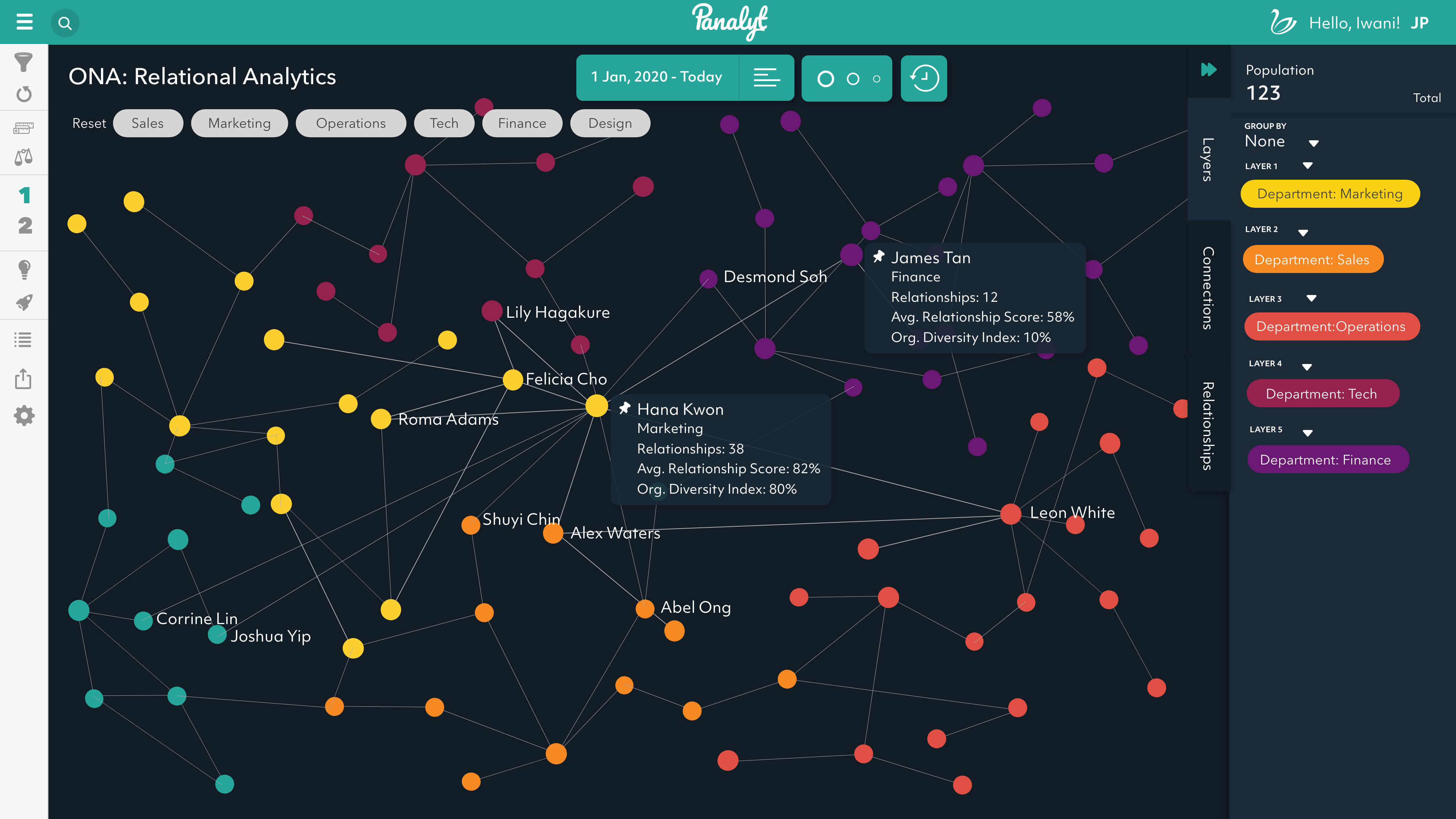Case Studies from Uber, Genpact & McKesson For Driving Business Impact with Relational Analytics

Looking for real-life case studies on companies leveraging Relational Analytics to drive improved business and employee outcomes? We’ve curated a comprehensive list of resources for you – enjoy reading!
Global Japanese Conglomerate (Panalyt Client): Enabling a Global Japanese Conglomerate Improve Remote Employee Onboarding
A global Japanese conglomerate traditionally hired 200–300 new graduates in Japan each year in a comprehensive onboarding program with frequent rotations and manager check-ins to help new hires build a strong sense of loyalty towards the organization.
This year, remotely onboarding new hires was a major source of concern — so much so that management considered scrapping the new graduate program for 2020. Cue Panalyt. Using Panalyt’s Relational Analytics capabilities, the company was able to get a real-time view with how new graduates were forming relationships within the organization, compared against the network behaviours of previous graduate hires during their first six months.
The strength relationships could be viewed across different dimensions, such as relationship strength with peers, relationship strength across grade levels, across departments and locations.
As an additional win, the conglomerate was also able to include new hires in Japan on global projects by leveraging Relational Analytics to identify areas of intervention where new hires needed help with successfully collaborating in a distributed environment.
Uber: Improving Sales Performance, Accelerating New Sales Rep onboarding, Predicting Attrition
Note: Panalyt Founder & CEO Daniel West was the Head of HR International at Uber at the time of this project Uber’s people analytics team leveraged Relational Analytics to analyze and understand the behaviours of high performing teams in the sales organization.
By looking internal and external networks of high performing sales reps, the team was able to identify that along with a strong external network, which was table stakes, strong sales reps also had strong internal networks across the company with their teams, with sales teams across other countries and also also other relevant departments — allowing them access to the information and the influence required to push a deal through successfully.
Uber’s People Analytics team was then able to compare the network behaviours of individual employees against the common attributes of high performing sales reps to identity areas of coaching to help them build the internal networks required to succeed in their roles.
Uber’s People Analytics team was also able to compare the network behaviours of current new hires with 3–6 months of tenure as compared to the common network attributes of sales reps with 2–3 year tenures during their onboarding to nudge sales reps and their managers to help them to expand their internal networks.
In addition, Uber’s People Analytics team also found that the number of meaningful connections was found to shrink rapidly in a sustained manner over 3–4 months before the employees left. While the average relationship strength with the remaining close connections ( mostly friends within the company) went up, the number of people they had a high relationship strength with within the company decreased drastically.
Exit interviews revealed that these people noticed that they were either pulling back or being pushed out of the company only 3–4 weeks before they left, allowing Uber to have a 3 month lead time to plan necessary interventions for high attrition risk talent.
McKesson: Increase Organizational Agility, Improve Sales Performance, Reduce Attrition, Improve Post-Merger Integration
McKesson initially started out with Relational Analytics to drive organizational agility by identifying influencers and brokers to facilitate communication towards transformation and shape the organization to be more agile.
McKesson was further able to validate that Relational Analytics can predict business outcomes. McKesson’s People Analytics team was able to find distinct connections between network behaviours and business outcomes, with predictive validity as well.
The following hypotheses were tested and validated:
Improving Sales Performance: Do high performing sales teams build relationships differently from low performing sales teams? Is there something in the way they build relationships, external vs internal, that is both common and differentiated? The more effective sales teams were found to have stronger, more balanced relationships. Top quartile sales teams were found to have both a strong external network as well as an internal network. High performing sales managers were found to have stronger internal networks across the company.
Reducing Turnover : Are high turnover teams different from low turnover teams? High turnover teams have strong relationships upwards in the hierarchy and externally, but meaningful gaps with peers and down the hierarchy. This observation led to McKesson designing a Flexible workplace strategy to close the gap between peer to peer and downward networks.
Improving Post-Merger Integration: Are employees being acquired by McKesson integrating with the company or are they staying ring-fenced? McKesson was able to validate that acquired hires were able to integrate well with the parent company within a year of acquisition.
Note: An additional area mentioned in this video was around using Relational Analytics to improve Diversity & Inclusion. This article by Michael Arena is an excellent resource that dives deeper into how Relational Analytics can be used to combat homophily of diverse talent within ERGs and facilitate the integration/ cross-pollination of diverse talent with the rest of the organization https://www.hrexchangenetwork.com/people-analytics/columns/diversity-at-the-core-of-the-network
Genpact: Predicting High Performing Leaders
Source: https://joshbersin.com/2018/10/what-emails-reveal-about-your-performance-at-work/
In this study on Genpact’s top 650 leaders done by Praful Tickoo at Genpact working with Peter Gloor at MIT, Genpact was able to predict “Rockstar” performers with 74% accuracy by applying a Deep Learning Model on the ONA data integrated with people data and business performance, statically proving that certain types of communication behaviour directly correlates to business performance.
The highest performing leaders were found to respond faster and communicate more often ( note this might differ from one company culture to another). High performing leaders were found to have a high network reach and built strong relationships across the company. In addition, high performers also received very quick responses from their peers due to their “influence” in the organization.
Genpact was also able to leverage Relational Analytics to predict attrition six months in advance. People who left the company were found to be significantly less engaged in their communications in the period leading up to their exit. Relational Analytics allowed Genpact to facilitate the discovery of potential factors that might lead to attrition and to repair a problem before it turns into a regrettable loss.
Note From the Panateers: Both Praful and Peter have played an important role in helping organizations understand and realize the potential benefits of Organizational Network Analysis, and were extremely generous in their advice to us as we were building out Panalyt’s Relational Analytics Capabilities. Praful, Peter – A big ‘THANK YOU’ from the Panalyt team to you!
Extra: Relational Analytics for Increasing Organizational Agility and Innovation

This HBR article which includes Rob Cross( another ONA pioneer we deeply respect at Panalyt) amongst the authors, focuses on how Relational Analytics can improve organizational agility and innovation across four dimensions — 1) managing the center of the network, 2) engaging the fringe, 3) bridging select silos, and 4) leveraging boundary spanners – to help Leaders to nurture their internal networks to produce better financial, strategic and talent-related outcomes. There’s a section in this article focussed on the topics of burnout/ collaboration overload and leadership development as well.
Note: We’ve also covered how Relational Analytics can be used to drive Innovation in one of our earlier Panalyt ONA webinars. All our Relational Analytics webinars are publicly available on the Panalyt YouTube channel
Extra: Relational Analytics + Skills Data
Reading these two articles by Adam McKinnon, currently the Global Head of People Analytics at QBE Insurance and previously the Head of Advanced People Analytics at Merck, back-to-back paints a fascinating picture of how employee skill data can be married with organizational network data to increase operational efficiency and knowledge management.
Read first: The Value of Measuring Employee Skill Data https://lnkd.in/disFtD4
Read after: How HR can Apply Network Analysis to Open Data https://lnkd.in/dvcZQhi
We hope you found this article useful in helping to make a business case for getting started with Relational Analytics at your Organization!
About Panalyt
Panalyt bridges the People-Data Gap, enabling real-time, uniform access to relevant people data, reports and insights for CxOs, HR and business managers.
People data, including employee interactions and connections is combined with business data empowering businesses to leapfrog to data-driven decision making, eliminating bias and improving engagement, sales effectiveness, productivity and, as a result, business performance.
Interested in a further discussion on how People Analytics and Relational Analytics can help you drive an improved employee and business outcomes? Book a 30-minute discovery call with our Panalyt co-founders to learn more!







